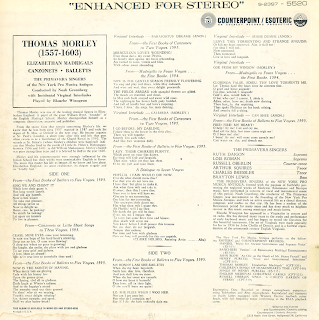Blue Thursday
New Sounds At The Roosevelt
Larry Elgart and His Orchestra
Ballroom At Home
Photo: Carl Fischer
Recorded in New York City, January and April, 1959
Recording Engineer: Ernest Oelrich and Bob Simpson
RCA Victor LSP-2045
From the back cover: The sounds enclosed by this album jacket are as distinguished as the Aston-Martin shown on its cover.
As the album title indicates, these are NEW SOUNDS AT THE ROOSEVELT. The fresh big band sounds are those of the Larry Elgart crew. The Roosevelt, of course, is the prominent New York hotel.
The facts of the invasion of the Roosevelt by the Elgart band are a revelation in themselves. For thirty years the Guy Lombardo band maintained residence at the hotel, playing sweetly to faithful audiences. The first band to replace Lombardo's was Larry Elgart's. And the average age of the audience dropped substantially, as young dance band fans flocked to hear the Elgart sound.
It is a polished, disciplined, jazz-oriented sound. The band's library isn't overpopulated with aged stock arrangements retained from the Prohibition era. Instead, Larry Elgart has compiled an array of modern, appealing arrangements, representing the efforts of some of America's best composer-arrangers.
For this album, for example, the well-known jazz tenor saxophonist Al Cohn contributed four originals: April, Blue Thursday, Cool-Aid and Let My People Swing. Trombonist Wayne Andre, formerly with Kai Winding's septet, delineated the Walkin' path, a route familiar to jazz soloists. Roger Middleton arranged the happy sound of Mountain Greenery. A member of the Elgart band's reed section, tenor saxophonist John Murtaugh, contributed several arrangements, too, including Yearning and Lagonda.
For balance, such reliable standards as Sleepy Time Gal, Wabash Blues, I Cried for You, Honeysuckle Rose, If Love Is Good to Me and Mountain Greenery were judiciously included.
The band's sound is as tasteful as its book, thanks to Elgart's mature direction. The 37-year-old saxophonist (he's featured on alto and soprano here) does not believe in relying on gimmicks. While other bandleaders futilely search for devices to lure dancing audiences, Elgart lures them effortlessly, simply by emphasizing good taste.
This is a band with broad potential appeal. It is a band for dancers; its rhythmic pulse is firm and its melodic expression is constant. It's a band, too, for jazz-oriented listeners. The arrangements are subtly provocative; the performances are crackingly precise without being mechanical. There's plenty of jazz flavor present. For just one ex- ample, dig the Miles Davis-ish atmosphere on Walkin'.
There aren't the sounds of the Count Basie band, because Larry isn't competing with Basie. They are among the most aware sounds in the dance band business today, however. They are the product of Larry's acutely perceptive nature, his ability to anticipate the desires of a dancing audience seeking modern sounds.
And he's a bandleader in the best sense of that term.
His band has an identity of its own. As both leader and soloist, he fronts the band effectively, too. Although many bands are led by figureheads, personable leaders without considerable musical ability, the members of the Elgart band respect, and are inspired by, Larry's proficiency on several reed instruments. He's best known as an alto soloist, but his efforts on soprano here indicate that he's one of the few musicians who can perform in non-strident fashion on that instrument. Finally, he's well qualified to select first-rate instru- mentalists to serve in the band.
The results of such efforts, aims and artistry are obvious.
The band doesn't manhandle ballads. It doesn't emasculate bluesy strolls. It doesn't manufacture excitement through technical facility alone; a collective spirit makes each performance memorable.
It's encouraging to learn that in this stereo age there is at least one band able to resist the temptation to create sound effects instead of music. The wide range of the Elgart book is tailor-made for the potential of stereo sound, without any distortion or tricks required. What emerges when the best in high fidelity reproduction technique is applied to the sound of the Elgart band is a thoroughly musical, genuinely moving experience.
If this swinging sound could dent the Lombardo empire at the Roosevelt, it's certain to prove as successful in penetrating other challenges, major or minor, wherever it is heard.
The new sounds at the Roosevelt could grow old at that respected location. But Larry Elgart won't permit it. He'll see to it that they remain new next year, too.
He knows he's in command of a very big band. – HUGH M. HEFNER (Editor and Publisher, Playboy Magazine)
Let My People Swing
Yearning (Just For You)
You Should Have Told Me
I Cried For You
Honeysuckle Rose
If Love Is Good To Me
Mountain Greenery
Cool-Aid
Sleepy Time Gal
Lagonda
April
Wabash Blues
Blue Thursday
Walkin'


















